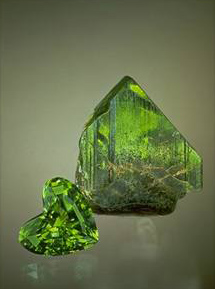
Back تشابه بلوري (علم البلورات) Arabic Isomorfisme (química) Catalan Izomorfie Czech Isomorphie (Kristall) German Isomorfismo mineral Spanish Isomorfismo (kristalografia) Basque همریختی (بلورنگاری) Persian Isomorphisme (chimie) French Izomorfija Croatian Իզոմորֆություն Armenian

In chemistry, isomorphism has meanings both at the level of crystallography and at a molecular level. In crystallography, crystals are isomorphous if they have identical symmetry and if the atomic positions can be described with a set of parameters (unit cell dimensions and fractional coordinates) whose numerical values differ only slightly.[1]
Molecules are isomorphous if they have similar shapes. The coordination complexes tris(acetylacetonato)iron (Fe(acac)3) and tris(acetylacetonato)aluminium (Al(acac)3) are isomorphous. These compounds, both of D3 symmetry have very similar shapes, as determined by bond lengths and bond angles. Isomorphous compounds give rise to isomorphous crystals and form solid solutions.[2] Historically, crystal shape was defined by measuring the angles between crystal faces with a goniometer. Whereas crystals of Fe(acac)3 are deep red and crystals of Al(acac)3 are colorless, a solid solution of the two, i.e. Fe1−xAlx(acac)3 will be deep or pale pink depending on the Fe/Al ratio, x.
Double sulfates, such as Tutton's salt, with the generic formula MI2MII(SO4)2.6H2O, where MI is an alkali metal and MII is a divalent ion of Mg, Mn, Fe, Co, Ni, Cu or Zn, form a series of isomorphous compounds which were important in the nineteenth century in establishing the correct atomic weights of the transition elements. Alums, such as KAl(SO4)2.12H2O, are another series of isomorphous compounds, though there are three series of alums with similar external structures, but slightly different internal structures. Many spinels are also isomorphous.
In order to form isomorphous crystals two substances must have the same chemical formulation (i.e., atoms in the same ratio), they must contain atoms which have corresponding chemical properties and the sizes of corresponding atoms should be similar. These requirements ensure that the forces within and between molecules and ions are approximately similar and result in crystals that have the same internal structure. Even though the space group is the same, the unit cell dimensions will be slightly different because of the different sizes of the atoms involved.
- ^ Girolami, Gregory (2015). X-Ray Crystallography. University Science Books. ISBN 978-1-891389-77-1.
- ^ Wells, A.F. (1984). Structural Inorganic Chemistry (5th ed.). Oxford University Press. ISBN 0-19-855370-6. pp 186–186 in 3rd. edition
© MMXXIII Rich X Search. We shall prevail. All rights reserved. Rich X Search